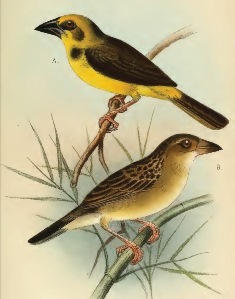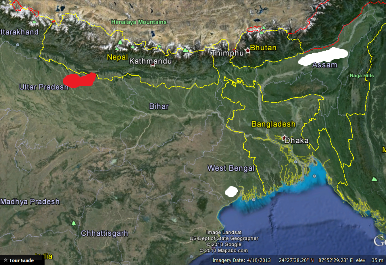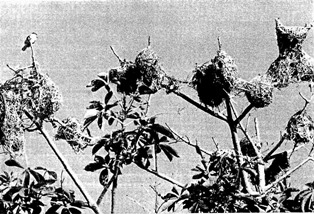Weaver Wednesday [77]: Finn's Weaver 2013-12-04 (456)
 Weaver Wednesday
Weaver Wednesday

The Finn's Weaver Ploceus megarhynchus is a large yellow weaver with dark ear-coverts, and heavily streaked upperparts. The female is duller. The female and non-breeding male Baya Weaver P. philippinus is smaller with a shorter, narrower bill and without the dark side breast-patch.
Two subspecies of the Finn's Weaver are recognised (see map below, based on Handbook of the Birds of the World, Vol. 15):
P. m. megarhynchus in Uttar Pradesh in India and just crossing into Nepal (see red on map).
P. m. salimalii, in West Bengal and Assam in India (see white on map). The breeding male of this subspecies usually has a larger brown mask and paler belly to undertail-coverts.
The global population is small and probably in rapid decline, due to human population pressure and loss of its habitat (terai grasslands). The recently discovered population in Royal Sukla Phanta Wildlife Reserve, in Nepal, probably has less than 50 individuals. This threatened species (see here) is regularly captured for the cagebird trade.

The Finn's Weaver inhabits grassland with scattered trees, especially in seasonally flooded areas. It is also found in rice paddies and other cultivated fields. It roosts communally in tall grass and sugar cane.
The Finn's Weaver feeds mainly on seeds, including hemp and rice, by foraging in grass and rice paddies together with other weaver species. It feeds its young mainly on insects.
The Finn's Weaver is polygynous, with up to four females per male. It is colonial, sometimes breeding in association with other weavers. The nest is ball-shaped without an entrance tube, though it may have a porch-like projection over the entrance. The nest is lined by the female with soft grass-heads or bulrush fluff. The nest is supported by branches, not suspended as is the case in many other weavers. The leaves around the nests are stripped to make the colony more conspicuous. Adjacent nests may be close together and even joined by strands of material. Nests are placed high up in trees, or sometimes low over water in reeds and bulrushes. Possibly early in the season nests are built in trees and later in reedbeds.

The Finn's Weaver may nest in the same tree as nesting Black Drongos Dicrurus macrocercus, which attack nest predators such as raptors and crows. Some weavers nest in trees with jungle bees, also for protection from predators. The plain white eggs are incubated by the female only. The chicks are fed by the female, and sometimes the male helps. Nestlings have been taken by House Crows Corvus splenden and Large-billed Crows Corvus macrorhynchos.
The Finn's Weaver has no PHOWN records (see PHOWN summary). Several colonies have disappeared in recent decades, so it is critical to document as many colonies as possible, of this Vulnerable species. Submit any weaver nest records to PHOWN (PHOtos of Weaver Nests) via the Virtual Museum upload site.
PHOWN summary
Previous Wedn: Cardinal Quelea
Full weaver species list
| 

 Weaver Watch
Weaver Watch


